Chief Buffalo and Benjamin Armstrong
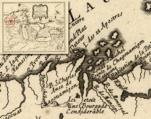

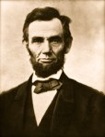
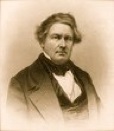
Chief Buffalo of La Pointe was the leader of the Lake Superior Chippewa tribe in the 1800s.
Birth and death details: He was born on Madeline Island, one of the Apostle Islands in Lake Superior. Different years of his birth have been reported. For example, a Minnesota Historical Society document says he was born in 1780. Other reports put his birth year as 1759. He died in September 1855 on Madeline Island, Wisconsin.
Ancestry: There are different reports regarding Buffalo’s father. Some say his father was Ou-daig-weos (or On Daig Weos), or The Raven’s Meat, born in Canada. Other reports say the name Ou-daig-weos is another form of the name Andaigweos, or The Crow’s Meat. For example, William Whipple Warren’s “History of the Ojibway People” from 1885 on page 225 says, “Buffalo of La Pointe was the grandson of Andaigweos. According to a family tradition, Andaigweos had been made a chief by the French.” Click here for more on Warren’s book. The “Handbook of American Indians North of Mexico, Part 2” (1910) says “He was the grandson of chief Augdaweos, which seems to have been also the name of his father.” Click here to read Buffalo’s stories about this great-grandfather, his great-great grandfather and their first encounter with European frontiersmen, on pages 83 to 88 of Benjamin Armstrong’s memoirs.
Conferring with three U.S. presidents
Chief Buffalo and Benjamin G. Armstrong lived in the Lake Superior frontier of Wisconsin. But individually or together the men met with three U.S. presidents in Washington, D.C.
Abraham Lincoln: In 1862, Benjamin Armstrong took a delegation of nine Chippewa chiefs to Washington to meet President Lincoln. The president told them: “My children, when you are ready, go home and tell your people what the great father said to you; tell them that as soon as the trouble with my white children is settled I will call you back and see that you are paid every dollar that is your due, provided I am here to attend to it, and in case I am not here to attended to it myself, I shall instruct my successor to fulfill the promises I make you here today.” Armstrong later wrote: “The older Indians have not forgotten what President Lincoln told the delegation in 1862, and the younger ones know it also ... I have made several attempts myself to bring this settlement about but have never been able to do so.” (See the “Meeting with Lincoln” page on this site for more details.”)
Franklin Pierce: Chief Buffalo and other Chippewa leaders met with President Pierce in February 1854. It was on this trip that a model for Chief Buffalo’s marble and bronze busts in the U.S. Capitol was made, according to U.S. Senate documents. The Wisconsin Magazine of History adds that despite Buffalo’s “advanced age he made the difficult overland winter journey from Lake Superior to a railhead several hundred miles to the south.”
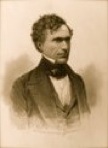
Millard Fillmore: Chief Buffalo and Benjamin Armstrong met with President Fillmore in June 1852. The meeting halted attempts to remove the Lake Superior Chippewa from their homes.
The Wisconsin Magazine of History in 1972 and 1973 printed four lengthy excerpts from Armstrong’s memoirs, under the title “Reminiscences of Life Among the Chippewa.”
Part 1 declared: How Armstrong “came to spend most of his adult life in companionship with Indians makes for a rousing tale ... He appeared to have been well aware of the normal inability of an aged man to recall names and dates with precision. In his preface he disarms the reader with his candor in this respect, at the same time maintaining that the events he describes are correct in their essential details. Careful consultation of the appropriate sources proves the validity of his contention ... Printed on cheap newsprint, Armstrong’s book was not designed to withstand the ravages of time. In fact, the Society’s copy, kept in the relative immunity of its library’s rare book room, crumbled while being xeroxed for editing. Its fragility, together with the probable scarcity and utility of such copies as may remain in home or other libraries, played a major role in the decision to republish at least a portion of the memoirs before they become irretrievably lost.” Click here for Part 1
Part 3 noted Armstrong’s reminiscences “reprinted here with emendations and corrections, are such a record of people and events in a little-known aspect of Wisconsin’s total heritage.” Click here for Part 3
For the other two installments, click here for Part 2 and click here for Part 4
Web resources
For the U.S. Senate’s biography of Chief Buffalo, click here
For the Red Cliff Band of Lake Superior Chippewa on Chief Buffalo has the “founder” of their reservation, click here
For Wikipedia’s entry on Chief Buffalo, click here
For information on the Chief Buffalo Mural Project of the Bayfield School District, click here
To read “Early Life Among the Indians: Reminiscences from the Life of Benj. G. Armstrong,” click here for Google Books or you can click here for the Wisconsin Historical Society version
Print resources
History of the Ojibway People” by William Whipple Warren (1885)
“Kitchi-Gami: Like Among the Lake Superior Chippewa” by Johann George Kohl (1885)
“La Pointe: Village Outpost on Madeline Island” by Hamilton Nelson Ross (1960)
“Ojibwe Journeys: Treaties, Sandy Lake and the Waabanong Run” by Charlie Otto Rasmussen (2003)
“Kitchi-Gami: Life Among the Lake Superior Chippewa” by Johann George Kohl (1885)
“History, Tradition and Adventure in the Chippewa Valley” by William W. Bartlett (1929). Also available on the Web by clicking here
“Madeline Island & the Chequamegon Region” by John O. Holzhueter (1997)
“Chief Buffalo and other Wisconsin-related Art in the National Capitol,” by John O. Holzhueter in the summer 1973 issue of the Wisconsin Magazine of History.
“Life with the Ojibwe: A Northern Land” by Howard D. Paap (2001).
“Handbook of American Indians North of Mexico, Part 2,” edited by Fredrick Webb Hodge (1910). Also available on the Web by Google Books by clicking here
“They Would Not Be Moved: The Chippewa Treaty of 1854,” by Edmund J. Danziger Jr. in Minnesota History (Spring 1973).
“Descendants, U.S. Capitol remember Great Chief Buffalo” by Dennis McCann in the Milwaukee Journal Sentinel (July 28, 1998)
“An Ethnographic Study of Indigenous Contributions to the City of Duluth” by Bruce M. White of Turnstone Historical Research (July 2015). The Turnstone Web site is available by clicking here
“History of Duluth and St. Louis County, Past and Present, Volume 1” by Dwight Edwards Woodbridge and John Stone Pardee (1921). Also available on the Web by Google Books by clicking here

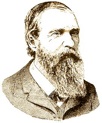
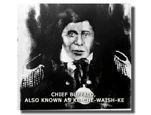
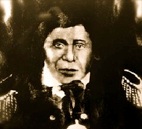
Chief Buffalo
Also known as: the Buffalo, Great Buffalo, the Buffalo Chief, Great Chief Buffalo, Chief Great Buffalo, Moses Buffalo, Great First One, Le Boeuf, Be sheekee, Bezhike, Pe-zhe-ke, Peezhickee, Peshickee, Kitchi Waishke, Gitspee Waishkee, Ke-che-waish-ke, and Ke-che-wash-keenh.
Benjamin G. Armstrong was a frontier trader, farmer, logger and Chippewa-English interpreter in the Lake Superior region in the 1800s. Armstrong guided Chief Buffalo and four other Lake Superior Chippewa tribal members on their 1852 journey to Washington to meet with President Fillmore to stop the removal of the band to land to the west. Later, President Lincoln’s Indian Affairs Commissioner William P. Dole appointed Armstrong as a special interpreter. Armstrong selected nine Minnesota and Wisconsin chiefs to meet with President Lincoln on a trip to Washington in 1862. His 1892 memoirs — titled “Early Life Among the Indians — Reminiscences from the Life of Benj. G. Armstrong” — have been digitized by Google Book and several other Web sites. The magazine of the Wisconsin Historical Society also reprinted a year-long series of excerpts of his memoirs in the early 1970s.
Descriptions: Armstrong has been called “one of the most intriguing characters in the history of the Apostle Island” (click here for more), “the best known of the traders who were working in the Chequamegon region in the 1850s” (click here), “one of the framers of the economy in the Chequamegon area,” “the chronicler of Ojibwe history in the Apostle Island region” (click here), “probably the best friend and counsellor that the Chippewa have ever had” (click here) and a “well-known interpreter” (click here).
Birth and death details: Most reports say he was born on July 4, 1820 in Alabama and died July 31, 1900 in Ashland, Wisconsin. Census records indicate his mother and father were born in Pennsylvania. One record says he was born in 1819.
Marriage: Government documents and published reports suggest that Benjamin Armstrong may have had two wives, the first being Caroline (Chief Buffalo’s daughter) and after her death, Charlotte (Chief Buffalo’s niece). But some observers suggest these were the same person. One version say
Armstrong was first married to Caroline Buffalo (born 1830) and they had one child, George, born 1848. Caroline is said to have died shortly after George’s birth. Armstrong later married to Charlotte, or Charollete (born in 1835 or 1836 according to Census records). See one BIA document and other historical records below. What is clear is that his wife took an active part in the family’s decision-making. For example, Benjamin writes in his memoirs about a business decision. “I told him I would talk the matter over with my wife,” he writes. “I talked the matter over with my family and told my wife I would do as she thought best. She ... advised me to accept his proposition.”
Occupations: Jockey, store owner and trader, farmer, logger, interpreter for the Chippewa and U.S. government, and counsel to the Lake Superior Chippewa.
From the Wisconsin Historical Society: “In 1840 Armstrong took up his residence among the Indians of northern Wisconsin, learned the Ojibwe language, and became a well-known interpreter. He won their friendship by respecting traditional life and culture, and was welcomed into the family of the most respected leader of the Lake Superior bands ... Through his connections with Chief Buffalo's family, Armstrong had access to leaders of all the Ojibwe bands. His book contains their recollections of battles with Sioux adversaries, memoirs of the Sandy Lake tragedy, accounts of the crucial treaty councils that defined modern Ojibwe life, the arrival of miners and loggers in the Ojibwe homelands, and much more.”
From the Wisconsin Archeologist journal of the Wisconsin Archeological Society, 1928: “He was the adopted son of Chief Buffalo, and was probably the best friend and counsellor that the Chippewa have ever had. The name given to him by his Indian friends was Zhah-bahsh-kung, or ‘the man who goes through.’ It implies persistency and thoroughness.”
U.S. Supreme Court cases: Benjamin and Charlotte Armstrong were mentioned in two U.S. Supreme Court cases regarding the right to land they received via the federal government’s 1854 Treaty with the Chippewa. The cases are Prentice v. Stearns from 1885 and Prentice vs. Northern Pacific Railroad from 1894. (Armstrong’s book was central in the U.S. Court of Appeals for the Seventh Circuit decision in 1982 in Lac Courte Oreilles Band of Lake Superior Chippewa Indians v. Voigh. The court’s use of Armstrong’s writings to help validate tribal rights to off-reservation natural resources produced an attack by anti-treaty groups on his memoirs.)
His memoirs: The complete title of the book is “Early Life Among the Indians — Reminiscences from the Life of Benj. G. Armstrong. Treaties of 1835, 1837, 1842 and 1854. Habits and Customs of the Red Men of the Forest. Incidents, Biographical Sketches, Battles. Dictated to and written by Thos. P. Wentworth.” Published by the Press of A.W. Bowron, Ashland, Wis., 1892. An Antiquarian Booksellers Association of America posting regarding a first edition of book that was up for sale for $750 says: “Uncommon on the commercial market; only one copy at auction in the past 40 years. Recollections of a pioneer, hunter, and fur trader among the Indians of Wisconsin and Minnesota dating from 1835 onward, providing a valuable source of the history of the fur trade in the region.” The Wisconsin Magazine of History in 1972 and 1973 printed four lengthy excerpts titled “Reminiscences of Life Among the Chippewa,” calling them “a record of people and events in a little-known aspect of Wisconsin’s total heritage.” Benjamin Armstrong’s legacy today is not without controversy, ranging from attacks by anti-treaty activities who dispute the use of his memoirs in courts of law, to one scholar who suggests Armstrong ultimately played a negative role in the loss tribal land in present-day Duluth. Commissioned by the City of Duluth in 2015, “An Ethnographic Study of Indigenous Contributions to the City of Duluth” by Turnstone Historical Research takes a critical — and at times seemingly speculative — view on Armstrong’s actions and motivations.
Childhood/Early days: Armstrong writes in his memoirs that: “I was born in the State of Alabama in the year 1820, and at the age of ten years, having had less than three weeks' schooling, I was decoyed away from home by a man named Thomas, who was engaged in horse-racing, traveling all over the Southern states. In the summer of 1833 we went to New Orleans, La., where I was injured by a fall from a horse, and just after this and before I had recovered from that injury, I was taken sick with a fever which lasted for a number of weeks. Mr. Thomas and his party left me there with directions to follow as soon as I was able. They went on to Holly Springs, Miss. I started in about four weeks and reached Holly Springs, but had left my bed too soon and there had a relapse, and from that time until spring was not able to do any work. I was then moved to Decatur, Ala., and a short time afterward to Athens, where I met Mr. Thomas, who said: ‘Perhaps you had better go home, for probably you will never be able to ride in a race again.’ ... During all the time I had been with Mr. Thomas I was known by an assumed name, so that my mother would not find out where I was.” He says in his book: “From 1840 to 1844 my time was spent more or less in roving around the country from St . Croix Falls to Lake Superior and beyond, to the source of the Mississippi.”
U.S. Census information: The 1860 Census lists “farmer” Benj. and Charlotte Armstrong of La Pointe Township with five sons.Charlotte’s age is listed at 24 and race Indian. The race of the children is listed as “H.” The 1870 Census lists Benj. Armstrong, age 50 and Charlotte Armstrong, age 35, of Bayfield.
Benjamin Green Armstrong
Also known as: Shaw-Bwaw-Skung or Zhah-bahsh-kung, meaning "the man who goes through." The name “implies persistency and thoroughness.”
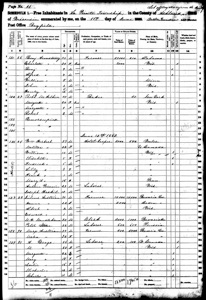
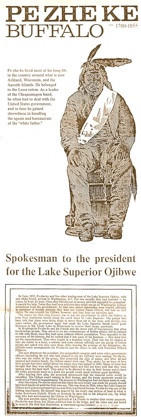
Biographical information: Buffalo’s biography from a U.S. Senate document says: “Be sheekee was chief of the La Pointe band of Ojibwa, located on Lake Superior in Wisconsin; he also led all the Lake Superior and Wisconsin bands of Ojibwa during much of this cultural transformation ... Be sheekee traveled to Washington, D.C., in 1852 and 1855 as part of official Native American delegations to discuss and sign treaties with the U.S. government. During his first visit, Be sheekee met with President Millard Fillmore to successfully settle a number of grievances. In 1855, together with Aysh-ke-bah-ke-ko-zhay, another Ojibwa chief, and 14 other Native Americans from Minnesota and Wisconsin, Be sheekee negotiated a land cession treaty.”
An obituary from the Wisconsin Historical Society Collections (1857) says: “He was the head, and the most able and distinguished, chief of the Chippewa Indians — noted and known for his rare integrity, wisdom in council, his power as an orator, and for his magnanimity as a warrior. That voice — so often sounded from the forum — so potent at the treaty of ’42 (our Government with the Chippewa bands) is silent forever.”
The above classroom education poster published by the Minnesota Historical Society’s on Chief Buffalo’s life notes: ”Pe-zhe-ke lived most of his long life in the country around what is now Ashland, Wisconsin, and the Apostle Islands. He belonged to the Loon totem. As a leader of the Chequamegon band, he often had to deal with the United States government, and in time he gained shrewdness in handling the agents and bureaucrats of the ‘white father.’”
The “Handbook of American Indians North of Mexico, Part 2” (1910) by Frederick Webb Hodge says: “He is spoken of as one of the most distinguished chiefs of the Chippewa tribe ... When Buffalo was about 10 years of age his family removed to the vicinity of the present Buffalo, N. Y., where they remained two years, then went to Mackinaw, there residing several years, and thence returned to La Pointe ... His name is signed to the treaties of Prairie du Chien, Wis., Aug. 19, 1825 (‘Gitspce Waskee, le Ixeuf of La Pointe’); Fond du Lac, Wis., Aug. 5, 1826 (‘Peezhickee’); St Peters r. (Wisconsin side), July 29, 1837 (‘Pezheke’); La Pointe, Wis., Oct. 4, 1842 ( ‘Gitchiwaisky’); Fond du Lac, Aug. 2, 1847 (‘Ke-che-wash-keen’), and La Pointe, Wis., Sept. 30, 1854 (‘Ke-chewaish-ke’). Schoolcraft ... says that ‘Gitchee Waishkee, the Great First-born’ was familiarly called ‘Pezhickee, or the Buffalo.’ ... Commissioner Manypenny, who was with him when he died, he presented his pipe and tobacco pouch, desiring him to take them to Washington.”
Benjamin Armstrong writes in his memoirs that “Buffalo always set a good example, was very industrious; a man of immense frame and an iron constitution. I have heard many stories related of him when he was young and related by people of his own tribe. They claimed he was a great hunter and the best bow and arrow shot of his time. It was said that in his prime he shot the swiftest arrow of any man then known. His practice was to frequently give his people good advice, more like a father to them than a domineering chief.”
Marriage: One report says Buffalo’s spouse was Magdalena Me Wa Dan A Kwead Okwe (born 1815). And they had 10 children: John Baptiste, Caroline, Joseph, Antoine, Joeseph Peter, Agatha, Esther, Maria, Michael and Marguerite, all with the last name Buffalo.
Chief Buffalo’s funeral: The 1960 book “La Pointe: Village Outpost on Madeline Island” by Hamilton Nelson Ross notes: His “Ojibway name was Bezhike, but he also was known as Kechewaishkeenh — the latter with a variety of spellings. Bezkhike’s tombstone, in the Indian cemetery, has had the name broken off. The original epitaph was: Bezhike, principal chief of the Chippewa Lake Superior died Sept. 7, 1855. Aged 96 years.” Benjamin Armstrong’s 1892 book notes: “Chief Buffalo not being able to meet the commissioners, I requested them to go with me to see him, stating that I did not think he would last more than two or three days and I should like to have them talk with him on business matters, as he had told me himself that he could live but a few days at most. ... After some further talk the commissioners left, but I remained with the old veteran until he died. I gave him a decent burial. Calling all parties together we formed a procession and marched to the Catholic cemetery at La Pointe where we laid the old chief to rest. I ordered and placed in position a tombstone at the head of his grave.”
Clan/Totem Membership: Buffalo was a member of the Loon totem, or the Ah-ah-wauk. According to William Whipple Warren’s book, Chief Buffalo, “the respected and venerable chief of the La Pointe band, and principal chief of all the Lake Superior and Wisconsin bands, is the acknowledged head of this clan.”
The Minnesota Historical Society published this poster on Chief Buffalo’s life. Click here to see a larger version


This site is published by a member of the Minnesota Chippewa Tribe. Click here for more information


BIA record of Benjamin G. Armstrong
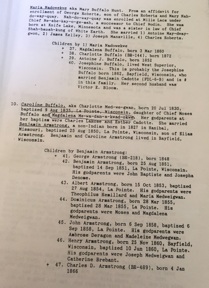
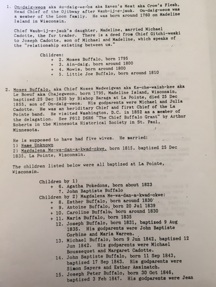
Historical records on the Chief Buffalo family